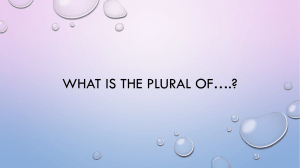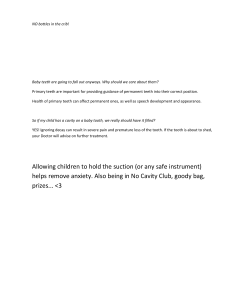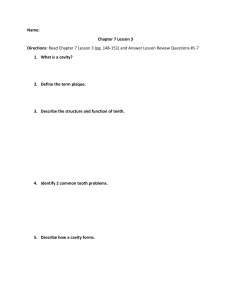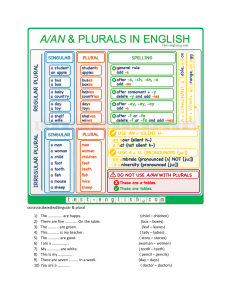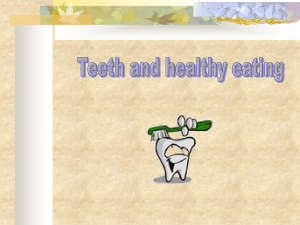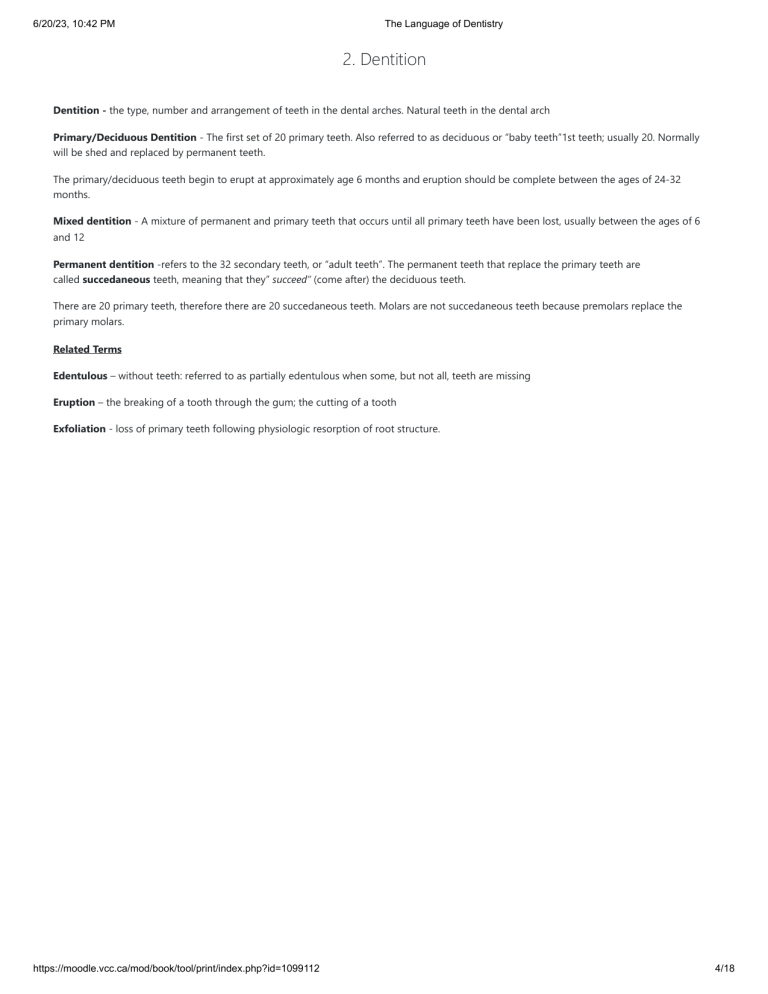
6/20/23, 10:42 PM The Language of Dentistry 2. Dentition Dentition - the type, number and arrangement of teeth in the dental arches. Natural teeth in the dental arch Primary/Deciduous Dentition - The first set of 20 primary teeth. Also referred to as deciduous or “baby teeth”1st teeth; usually 20. Normally will be shed and replaced by permanent teeth. The primary/deciduous teeth begin to erupt at approximately age 6 months and eruption should be complete between the ages of 24-32 months. Mixed dentition - A mixture of permanent and primary teeth that occurs until all primary teeth have been lost, usually between the ages of 6 and 12 Permanent dentition -refers to the 32 secondary teeth, or “adult teeth”. The permanent teeth that replace the primary teeth are called succedaneous teeth, meaning that they” succeed” (come after) the deciduous teeth. There are 20 primary teeth, therefore there are 20 succedaneous teeth. Molars are not succedaneous teeth because premolars replace the primary molars. Related Terms Edentulous – without teeth: referred to as partially edentulous when some, but not all, teeth are missing Eruption – the breaking of a tooth through the gum; the cutting of a tooth Exfoliation - loss of primary teeth following physiologic resorption of root structure. https://moodle.vcc.ca/mod/book/tool/print/index.php?id=1099112 4/18 6/20/23, 10:42 PM The Language of Dentistry 3. The Dental Arches In the human mouth, there are two dental arches: the maxillary and the mandibular. The layperson may refer to the maxillary arch as the upper jaw and the mandibular arch as the lower jaw. Maxillary arch (upper arch) – is actually a part of the skull, is not capable of movement. The teeth in the upper arch are set in the maxillary bone. Mandibular arch (lower arch) - is movable through the action of the temporomandibular joint, and it applies force against the immovable maxillary arch. When the teeth of both arches are in contact, the teeth are in occlusion. Temporomandibular Joint (TMJ) – joint on either side of the head where the mandible articulates(hinges) with the skull and allows for movement of the mandible. Related Terms Occlusion – The natural contact of the maxillary and mandibular teeth in all positions. Malocclusion – occlusion that is deviated (different) from a Class I normal occlusion. https://moodle.vcc.ca/mod/book/tool/print/index.php?id=1099112 5/18 6/20/23, 10:42 PM The Language of Dentistry 4. Quadrants Midline- The midline vertically divides each arch into two halves between the anterior central incisors. Two arches - each divided in half - make up the four quadrants. The midline is an imaginary line. Permanent Dentition When the maxillary and mandibular arches of permanent dentition are divided into halves, the resulting four sections are called quadrants, as follows: Maxillary right quadrant(Q1) Maxillary left quadrant(Q2) Mandibular left quadrant(Q3) Mandibular right quadrant(Q4) Each quadrant of permanent dentition contains eight permanent teeth (4 X 8 = 32), and a quadrant of primary dentition contains five teeth (4 X 5 = 20). When the maxillary and mandibular arches are each divided into halves, the resulting four sections are called quadrants as follows: Maxillary right quadrant (Q5) Maxillary left quadrant (Q6) Mandibular left quadrant (Q7) Mandibular right quadrant (Q8) FIG. 11-4 A, Primary dentition separated into quadrants. B, Permanent dentition separated into quadrants. (From Finkbeiner B, Johnson C: Comprehensive dental assisting, St. Louis, 1995, Mosby.) https://moodle.vcc.ca/mod/book/tool/print/index.php?id=1099112 6/18 6/20/23, 10:42 PM The Language of Dentistry ( Bird, Doni L.. Torres and Ehrlich Modern Dental Assisting, 11h Edition. Saunders Book Company, 042008.) Sextants Each arch can also be divided into sextants rather than quadrants. A sextant is one sixth of the dentition. There are three sextants in each arch. The dental arches are divided as follows: Maxillary right posterior sextant (S1) Maxillary anterior sextant (S2) Maxillary left posterior sextant (S3) Mandibular left posterior sextant (S4) Mandibular anterior sextant (S5) Mandibular right posterior sextant (S6) https://moodle.vcc.ca/mod/book/tool/print/index.php?id=1099112 7/18 6/20/23, 10:42 PM The Language of Dentistry 5. Tissues of the Tooth and Tooth Numbering Systems Enamel - is the hardest material in the body due to the fact that is highly calcified and mineralized. It is the white, protective external surface of the anatomic crown. Cementum - is the dull yellow external layer of the anatomic root. It is easily distinguishable from enamel by its lack of lustre and its darker hue. Dentin - makes up the main portion of the tooth structure, extends almost the entire length of the tooth. It is a hard, yellowish tissue underlying the enamel and cementum. It extends internally from the pulp cavity in the center of the tooth outward to the inner surface of the enamel (on the crown) and the cementum (on the root). Pulp - is the soft tissue (not calcified) tissue in the cavity or space in the center of the crown and root called the pulp chamber. Pulp is soft connective tissue containing a rich supply of blood vessels and nerves. These tissues enter and leave the tooth through the apical foramen. https://moodle.vcc.ca/mod/book/tool/print/index.php?id=1099112 8/18 6/20/23, 10:42 PM The Language of Dentistry 5.1. Anatomic Versus Clinical Crown and Root Crown – the top or highest part of an organ, tooth, or other structure. Anatomical crown – the part of the tooth extending from the cementoenamel junction to the Occlusal surface Clinical Crown – the portion or the natural tooth that is exposed (visible) in the mouth, from the gingival to the Occlusal plane or incisal edge. Root – is that portion of the tooth that is normally embedded in the alveolar process and is covered with cementum. Depending on the type of tooth, the root may have one , two, or three branches. Bifurcation means divided into two roots. Trifurcation means division into three roots. Anatomical root – the part of the human tooth covered by a cementum surface Clinical root – refers to the amount of tooth that is not visible since it is beneath the gingival. Related Terms Apex – tapered end of each root tip Apical - towards the apex or tip of the root of the tooth. Apical foramen – natural opening in the root. https://moodle.vcc.ca/mod/book/tool/print/index.php?id=1099112 9/18 6/20/23, 10:42 PM The Language of Dentistry 5.2. Tooth Surfaces Imagine a tooth as being similar to a box with sides. The sides of the teeth are named according to their alignment within the dental arch. Each tooth has five surfaces. 1. Vestibular- refers to the surfaces of the teeth which are toward the face -either lip or cheek. Facial-also refers to the vestibular The vestibular surfaces closest to the lips are also called labial surfaces. Facial surfaces closest to the inner cheek are also referred to as buccal surfaces. 2. Lingual – is the surface of mandibular and maxillary teeth that is closest to the tongue. The lingual surface of the maxillary teeth is also referred to as the palatal surface because that surface is closest to the palate. 3. Occlusal – is the chewing surface on the posterior teeth. 4. Incisal surface - is the cutting edge on the anterior teeth 5. Mesial – is the surface of the tooth toward the midline. 6. Distal – is the surface of the tooth distant from the midline Proximal surfaces - are those surfaces of the teeth which are adjacent to each other. Each tooth has two proximal surfaces. For example, the distal surface of the first premolar and the mesial surface of the second premolar are proximal surfaces. The areas between adjacent teeth surfaces are called interproximal spaces. FIG. 11-7 Surfaces of the teeth and their relationships to other oral cavity structures, to the midline, and to other teeth. (From Bath-Balogh MB, Fehrenbach MJ: Illustrated dental embryology, histology, and anatomy, ed 2, St. Louis, 2006, Saunders.) https://moodle.vcc.ca/mod/book/tool/print/index.php?id=1099112 10/18 6/20/23, 10:42 PM The Language of Dentistry 5.3. Tooth Numbering System Numbering systems are used as a simplified means of identifying the teeth for charting and descriptive purpose. There are three basic Numbering Systems. The system most commonly used in Canada is the International Standards Organization (ISO) system. The ISO system uses a two-digit tooth recording system. The first of the two digits indicates the quadrant, and the second digit indicates the tooth within the quadrant. Permanent teeth First Digit (quadrant #) Second Digit (Tooth #) 1. Maxillary right quadrant 1. Central Incisor 2. Maxillary left quadrant 2. Lateral Incisor 3. Mandibular left quadrant 3. Canine/cuspid 4. Mandibular right quadrant 4. First premolar/bicuspid 5. Second premolar/bicuspid 6. First Molar 7. Second Molar 8. Third Molar Deciduous/Primary First Digit Second Digit 5. Maxillary right quadrant 1. Central incisor 6. Maxillary left quadrant 2. lateral incisor 7. Mandibular left quadrant 3. Canine/Cuspid 8. Mandibular right quadrant 4. First Molar 5. Second Molar https://moodle.vcc.ca/mod/book/tool/print/index.php?id=1099112 11/18 6/20/23, 10:42 PM The Language of Dentistry 5.4. Deciduous and Permanent tooth numbering https://moodle.vcc.ca/mod/book/tool/print/index.php?id=1099112 12/18 6/20/23, 10:42 PM The Language of Dentistry 6. The Tissues Surrounding the Tooth The Periodontium supports the teeth within the alveolar bone, consists of the cementum, alveolar bone and the periodontal ligaments. These tissues protect and nourish the teeth. The periodontium is divided into two major units: the attachment apparatus and the gingival unit. 1. Attachment Apparatus Cementum was discussed earlier. Alveolar Process/bone – this is an extension of bone from the mandible and the maxilla which support the teeth in their functional position within the jaws. The alveolar process develops in response to the growth of developing teeth. When teeth are lost, bone from the alveolar process is resorbed and the ridge decreases in size and changes in shape. It is also referred to as the alveolar ridge. Alveolar Crest – is the highest point of the alveolar ridge. Alveolar socket - is the cavity within the alveolar process that surrounds the root of the tooth. Each tooth sits in its own alveolar socket. The tooth does not actually contact the bone at this point. Periodontal Ligament - is dense connective tissue organized into fibre groups that connects the cementum covering the root of the tooth with the alveolar bone of the socket wall. The periodontal ligament allows functional movement of the tooth and it absorbs shocks as the chewing forces are brought against the tooth. The fibres of the periodontal ligament attach at one end to the cementum of the root. The other end is attached to the bone of the socket. Imagine the periodontal ligament as a series of tiny springs which surround and support the tooth. This arrangement allows the tooth to withstand the pressures and forces of mastication. 2. The Gingival Unit Oral Mucosa - is the specialized mucous membrane (tissue) that lines the inside of the oral cavity. It is further specialized according to the area where it is located and the job it has to do. Gingiva - is commonly referred to as the gums, is specialized oral mucosa that covers the alveolar processes of the jaws and surrounds the necks of the teeth. Normal gingiva has the following characteristics: Surrounds the tooth like a collar Is self-cleansing Firm and resistant and tightly adapted to the tooth and bone Surfaces of attached and interdental papillae are stippled and resemble the rind of a orange. Color varies according to the individuals pigmentation Unattached Gingiva- also known as marginal gingiva is the border or free gingiva that surrounds the teeth in collar-like fashion. https://moodle.vcc.ca/mod/book/tool/print/index.php?id=1099112 13/18 6/20/23, 10:42 PM The Language of Dentistry Interdental Gingiva- also known as the interdental papilla (plural, papillae), is the extension of the free gingiva that fills the interproximal embrasure between two adjacent teeth. Attached Gingiva- is the gingival tissue that extends from the base of the sulcus to the mucogingival junction. It is firmly attached to the alveolar bone. Gingival Sulcus– is not seen visually but evaluated with a specialized instrument called a probe. It is actually the space between the tooth surface and the narrow free gingiva. A healthy gingival sulcus is from 1 to 3 millimetres in depth. (The depth of the gingival sulcus is shown by the periodontal probes that are measuring it) https://moodle.vcc.ca/mod/book/tool/print/index.php?id=1099112 14/18 6/20/23, 10:42 PM The Language of Dentistry 7. The Oral Cavity The entire oral cavity is lined with mucous membrane tissue. This tissue is moist and is adapted to meet the needs of the area it covers. The oral cavity is divided into the following two areas: 1.Vestibule – the space between the teeth and the inner mucosal lining of the lips and cheeks. 2.Oral Cavity Proper – the space on the tongue side within the upper and lower dental arches. Vestibule Is the area that begins on the inside of the lips and then extends from the lipsonto the alveolar process of both arches. The tissue lining the vestibules is thin, red, and loosely attached to underlying alveolar bone. Mucobuccal fold - is the base of each vestibule, where the buccal mucosa meets the alveolar mucosa. Buccal vestibule – is the area between the cheeks and the teeth or alveolar ridge Parotid papilla – located on the inner surface of the cheek on the Buccal mucosa. It is opposite the second maxillary molar. You can feel it with your tongue. This papilla protects the opening of the parotid duct of the parotid salivatory gland. Frenum –band of tissue that passes from the facial oral mucosa at the midline of the arch to the midline of the inner surface of the lip . Also called frenulum;plural frenula The Oral Cavity Proper The oral cavity proper is the area inside the dental arches. You can feel it with your tongue by holding your teeth together. Behind the last molars, there is a space that links the vestibule with the oral cavity proper. https://moodle.vcc.ca/mod/book/tool/print/index.php?id=1099112 15/18 6/20/23, 10:42 PM The Language of Dentistry Hard Palate – also known as the roof of the mouth it separates the nasal cavity above from the oral cavity below. You can feel this with your tongue. In the oral cavity the palate is covered with oral mucosa that is tightly bound to the underlying bone. Behind the maxillary centrals is the incisive papilla, a pear-shaped pad of tissue that covers the incisive foramen. Palatal Rugae – are irregular ridges or folds of masticatory mucosa that extend laterally from the incisive papilla Palatal Raphe – runs posteriorly from the incisive papilla at the midline. Soft Palate - is the movable posterior third of the palate. You can feel this by moving your tongue to the back of the hard palate. It has no bony support and hangs into the pharynx. Uvula- is a pear-shaped hanging projection of tissue that marks the end of the soft palate. Tongue– is composed mainly of muscles it is one of the body’s most versatile organs and is responsible for a number of functions: Speaking Positioning food while eating Tasting and tactile sensations Swallowing, cleansing the oral cavity It is covered on top by a thick layer of mucous membrane and thousands of tiny projections called papillae. Inside the papillae are the sensory organs and nerves for both taste and touch. The body – is the anterior two thirds of the tongue. The root – is the posterior part that turns vertically downward into the pharynx. Dorsum –is the superior (upper) and posterior roughened aspects of the tongue. It is covered with small papillae of various shapes and colors. Sublingual surface – is covered in thin, smooth, transparent mucosa through which many underlying vessels can be seen. There are two small papillae on either side of the lingual frenulum just behind the mandibular central incisors. The submandibular glands (caruncles) open into the mouth through these papillae and allow for saliva to enter the oral cavity. Salivary glands-The salivary glands produce saliva which lubricates and cleanses the oral cavity. Saliva enters the mouth through saliva glands/ducts located under the tongue and near the second permanent molar. https://moodle.vcc.ca/mod/book/tool/print/index.php?id=1099112 16/18 6/20/23, 10:42 PM https://moodle.vcc.ca/mod/book/tool/print/index.php?id=1099112 The Language of Dentistry 17/18 6/20/23, 10:42 PM The Language of Dentistry 7.1. Review Exercise Identify the following: 1. ________________________________ 2_________________________________ 3.________________________________ 4.________________________________ 5. The space between the teeth and the inner mucosa lining of the lips and cheeks is the ______________________. 6. What is the name of the pear-shaped pad of tissue located lingual to the maxillary central incisors? ______________________ 7. The structure that passes from the oral mucosa to the facial midline of the mandibular arch is the________________________. 8. Besides the oral cavity name the other region of the oral cavity. ________________ 9. This runs posteriorly from the incisive papilla at the midline to the border of the hard palate. _____________________. 10. Located on the inner surface of the cheek, it is opposite the second maxillary molar. You can feel it with your tongue and it protects the opening of the parotid duct. It is the _______________________. https://moodle.vcc.ca/mod/book/tool/print/index.php?id=1099112 18/18
